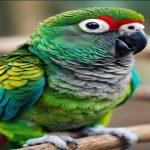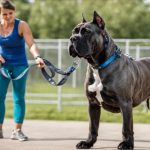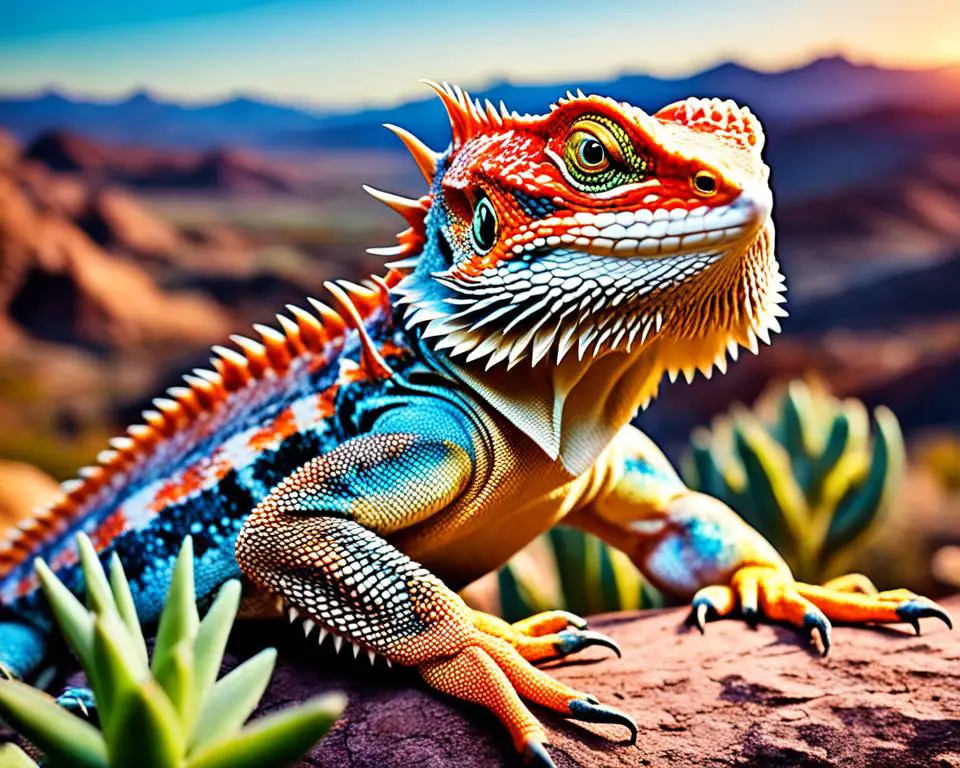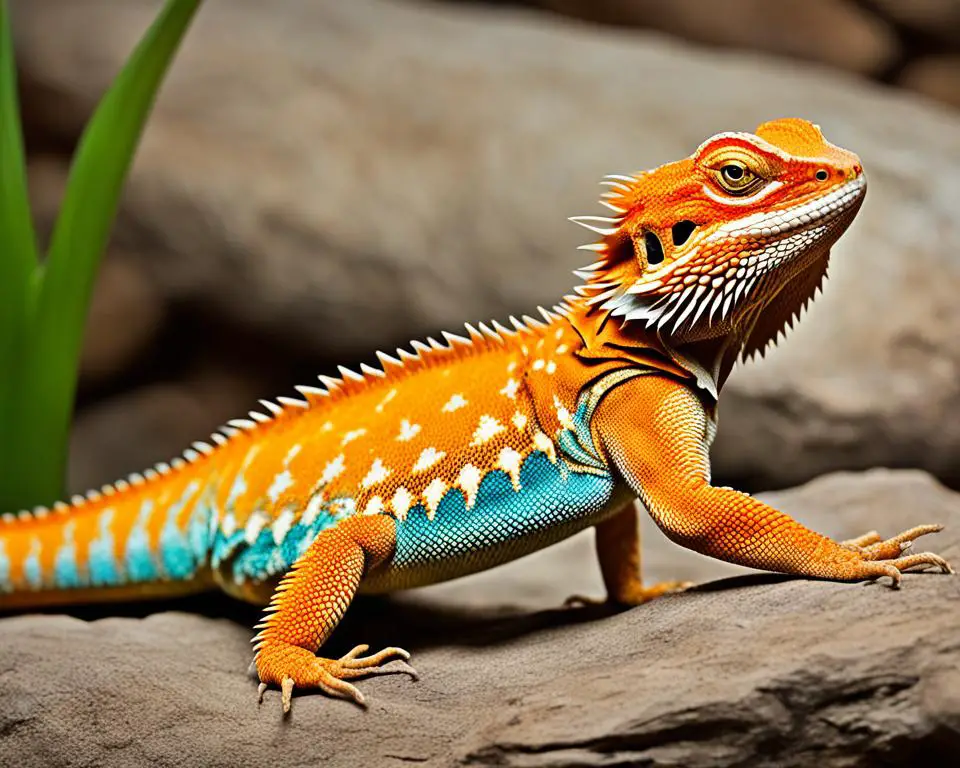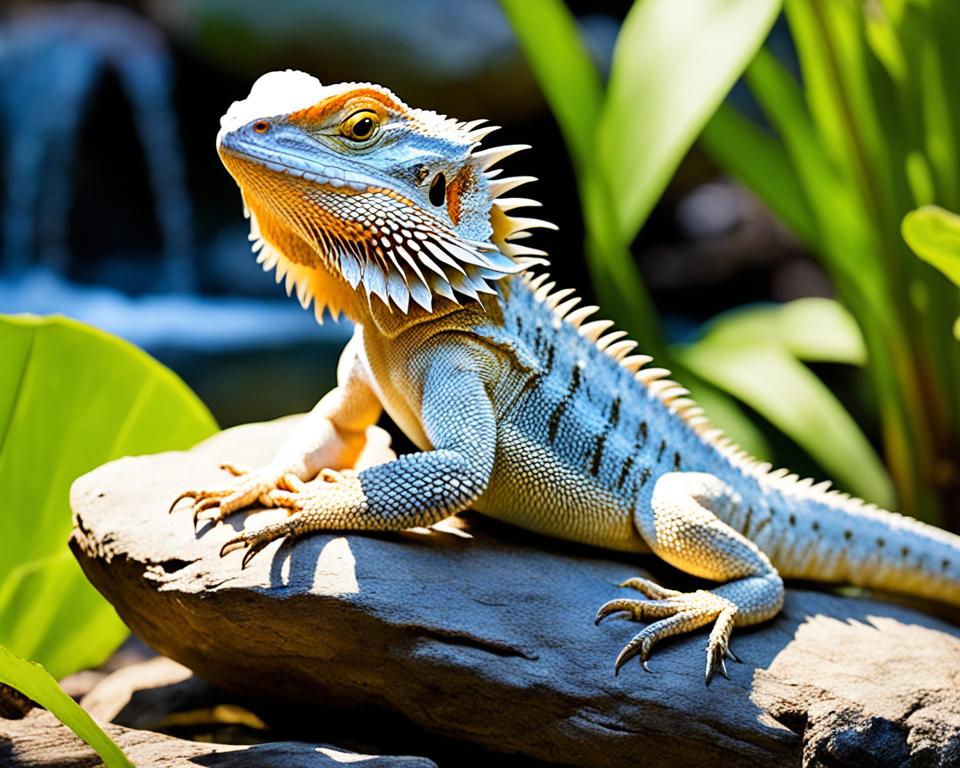Bearded dragons are fascinating reptiles that have captured the hearts of pet owners worldwide. Their unique appearance and friendly nature make them a popular choice for those seeking a reptilian companion.
But before we dive into the article, let’s address the question that some of you might have: do bearded dragons have teeth?
Bearded dragons have teeth. Bearded dragons have what is known as acrodont dentition, meaning their teeth are fused to the tip of their jawbones.
Let’s dive into the world of bearded dragon teeth and discover what makes them so unique.
Bearded Dragons Teeth: An Overview
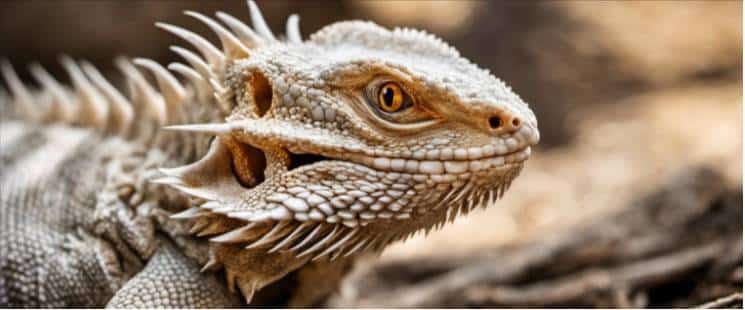
Bearded dragons (Pogona) are fascinating reptiles known for their unique appearance and friendly nature. One of the intriguing features of these creatures is their teeth, which differ from other reptile species.
Bearded dragons are characterized by acrodont dentition, which means that their teeth are fused directly to the jawbones. This is in contrast to pleurodont teeth, commonly found in other reptiles such as iguanas, where the teeth are attached to the inner side of the jawbones.
Read also: Coconut Oil on Bearded Dragons: Why, When, and How to Use It ([year])
Acrodont teeth are not easily replaceable, and therefore, bearded dragons need to take care of their teeth to prevent any potential dental issues.
How many teeth do bearded dragons have?
The number of teeth present in bearded dragons varies between individual specimens and different species. On average, they have approximately 11-20 teeth on each side of their upper jaw and 10-20 teeth on each side of their lower jaw, totaling between 40 and 80 teeth.
These teeth are small and triangular, making them suitable for a bearded dragon’s omnivorous diet, which consists of insects, vegetables, and fruits.
How to clean bearded dragon teeth?
- Use a soft-bristled toothbrush made specifically for small animals or a moistened cotton swab Bearded Dragon Teeth & Care: What Every Owner Needs To Know. Human toothbrushes may be too abrasive.
- Gently lift your bearded dragon’s lip to expose the teeth. Brush each tooth individually being careful not to stress the animal Dental Care for Bearded Dragons.
- Apply a small amount of reptile-safe toothpaste or a dilute chlorhexidine solution to the toothbrush or cotton swab. Don’t use human toothpaste as it may be too harsh.
- Brush the outer surfaces of each tooth in a circular motion for 30 seconds to 1 minute, 2-3 times per week To Brush or Not to Brush: Taking Care of Your Bearded Dragon’s Teeth.
- As an alternative to brushing, wipe teeth with a damp cotton ball or gauze pad to remove debris Bearded Dragon Teeth and How to Care for Them.
- Reward with treats after to positively reinforce tooth cleaning time. Consult an exotic vet with any dental concerns.
What do bearded dragons teeth look like?
Bearded dragon teeth have some distinctive features:
- Shape – They are small, triangular, and pointed. This shape helps them grasp and tear food.
- Number – Adults have 30-40 teeth total, arranged in rows in each upper jaw. Babies have fewer teeth that develop as they mature.
- Attachment – Bearded dragon teeth are acrodont, meaning they are fused directly to the tip of the jawbones, not embedded in sockets. This gives them a more fixed position.
- Color – Normally a pale cream or off-white color. Discoloration could indicate dental issues.
- Size – Very small, usually only a few millimeters in length for an adult. Hard to see without lifting the lip or using magnification.
- Arrangement – The teeth are positioned close together in each upper jaw in rows. There are no teeth in the lower jaw.
- Replacement – Unlike mammals, bearded dragons cannot regrow or replace lost teeth. Proper dental care is important to avoid loss.
So, bearded dragon teeth are tiny, triangular, and pale white or cream in color. They are fused directly to the jaw tip in close-set rows inside the mouth. Due to their small size, it may take some magnification to get a good look at them.
Do bearded dragon teeth fall out?
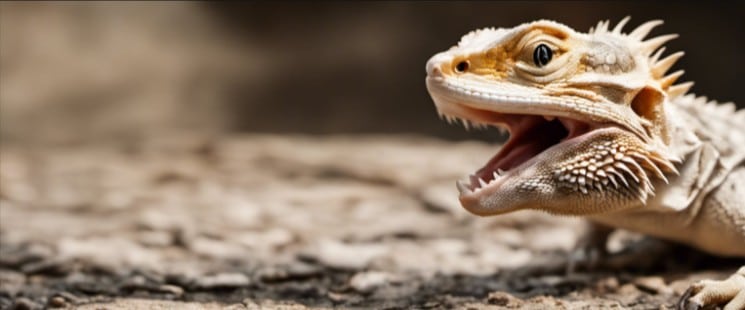
Bearded dragon teeth do not fall out naturally like human teeth. Unlike humans, bearded dragons have acrodont teeth, which means that their teeth are fused directly to their jawbone and are not easily replaceable.
However, dental issues such as infections, injuries, or trauma can lead to tooth loss in bearded dragons. Missing teeth can lead to complications such as infections and discolored teeth, which can further affect the overall health of our bearded dragons.
Therefore, taking proper care of their teeth and monitoring their dental health regularly is essential to prevent any potential dental problems.
Dental problems in bearded dragons
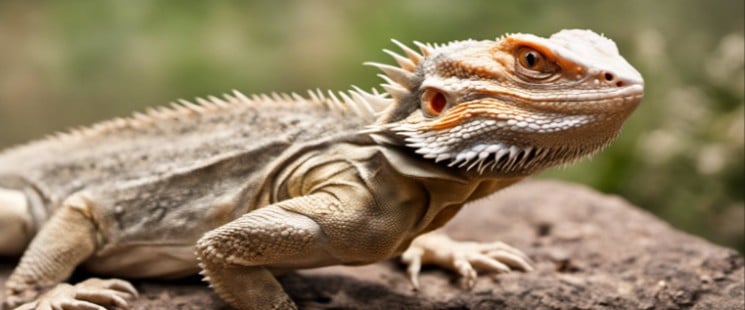
Gum disease and other infections
Gum disease, also known as periodontal disease, in bearded dragons can occur due to the buildup of bacteria and infection causing inflammation in the gums. Signs of gum disease in bearded dragons include redness, swelling, and bleeding gum tissue.
In severe cases, this may progress to gingivitis or periodontal disease. Infections in bearded dragon teeth may occur when bacteria penetrate the tooth’s dentin, leading to tooth decay or other dental problems.
Tooth loss and dental diseases
Tooth loss in bearded dragons can occur due to dental diseases, injury, or trauma. Stress and fighting among bearded dragons can also result in broken or lost teeth.
Missing teeth may lead to complications such as infections and discolored teeth, which further affect the overall health of our bearded dragons.
Mouth rot and other serious conditions
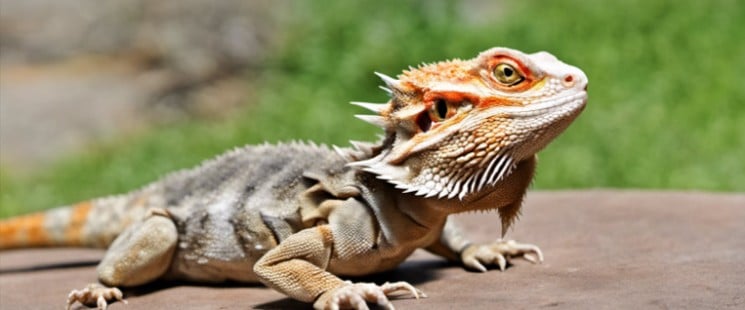
Mouth rot, scientifically known as stomatitis, is a painful condition characterized by symptoms such as swelling, bleeding gums, and black teeth. This condition can lead to complications like osteomyelitis, in which bacteria penetrate deep into the jaw bone, causing inflammation and bone infections.
Also, metabolic bone disease, or nutritional secondary hyperparathyroidism, can increase the risk of mouth rot in bearded dragons with a compromised immune system.
Risk factors and causes
Several factors contribute to dental problems in bearded dragons. These include:
- Poor diet. Feeding soft foods or a diet high in sugary items can increase the risk of dental issues.
- Genetics. Bearded dragons may inherit a predisposition for dental problems from their parents.
- Environmental stress. Stressful living conditions can weaken a bearded dragon’s immune system, making it more susceptible to dental issues.
How do you take care of bearded dragon’s teeth?
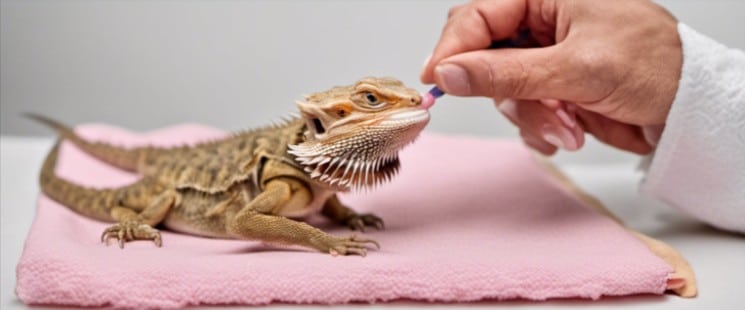
Taking care of a bearded dragon’s teeth is important for their overall health. Here are some tips:
Prevention and treatment
To prevent dental problems in bearded dragons, we recommend the following:
- Maintain a clean and healthy environment.
- Schedule regular checkups with a veterinarian.
- Clean and inspect the teeth for any signs of infection or damage.
- Use calcium powder on their food to promote strong teeth and bones.
If a dental issue is detected, treatment options include:
- Use a cotton ball soaked in a chlorhexidine solution to clean the affected area.
- Applying antiseptic or disinfectant as directed by a veterinarian.
- Administering antibiotics prescribed by a veterinarian to combat infections.
Bearded dragon’s diet and teeth
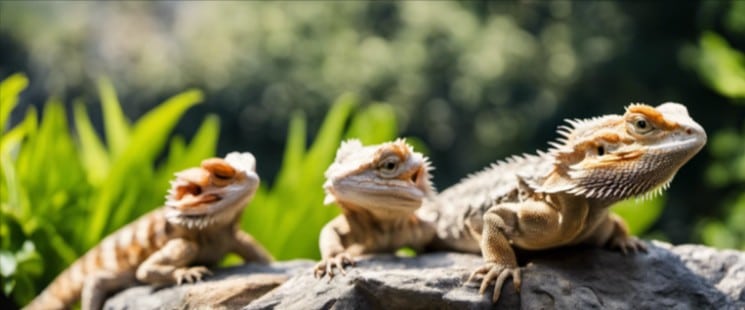
Importance of a healthy diet
A healthy diet is crucial for bearded dragons to maintain optimal health, including proper functioning of their teeth. Providing them with a balanced diet consisting of calcium-rich, protein-packed insects, and a variety of vegetables and fruits ensures their teeth grow strong and healthy.
Recommended foods for bearded dragons
A bearded dragon’s diet should consist of a mix of protein-rich insects, fruits, and vegetables. Including:
- Insects. Dubia roaches, waxworms, and other soft-bodied insects are high in protein and provide essential nutrients.
- Vegetables. Leafy greens, like collard greens, Swiss chard, and mustard greens are great choices for bearded dragons.
- Fruits. Occasional servings of soft fruits, such as berries, mangoes, and papayas, add hydration and vital nutrients.
It’s crucial to dust their prey with calcium powder before feeding to ensure an adequate intake of calcium.
Read also: What Bugs Can a Bearded Dragon Eat? ( 7 Must-Have Bugs)
Feeding practices and techniques
Feeding techniques play a significant role in maintaining a bearded dragon’s oral health. We recommend:
- Offering food in shallow dishes to minimize the risk of accidental bites on the enclosure’s substrate.
- Rotating between soft and harder foods, allowing bearded dragons to exercise gentle pressure on their teeth while avoiding excessive wear.
General bearded dragons care and husbandry
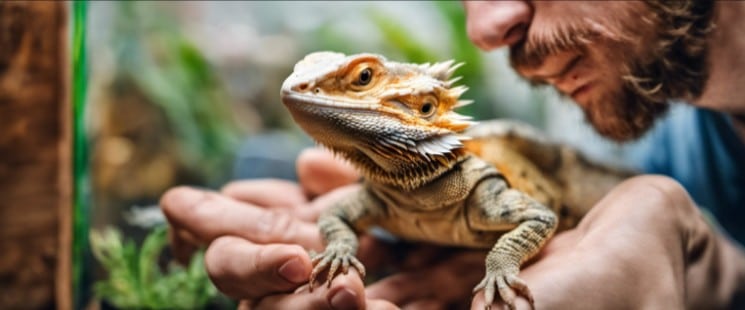
Proper lighting and environment
As bearded dragons caretakers, we should provide them with a proper environment that closely mimics their natural habitat. This includes adequate lighting, temperature gradients, and an appropriate living space.
For lighting, a combination of UVB and heat lamps are essential for bearded dragons’ well-being. UVB lights play a crucial role in calcium absorption and overall health, while heat lamps maintain a suitable basking area temperature between 95-110°F.
Remember to regulate the cooler side of the enclosure, ensuring a temperature range of 75-85°F for their comfort.
Handle with care: Teeth and biting
When handling bearded dragons, it’s essential to be gentle and approach them properly. Although they have small teeth, they can still bite when they feel threatened or stressed.
To carefully handle your bearded dragon, place your hand under their body, supporting their legs, and apply gentle pressure on their sides to keep them secure.
In case of biting, remember to stay calm and allow them to release their grip instead of forcefully pulling away.
Regular checkups with a veterinarian
Regular checkups with a veterinarian who specializes in reptile care is vital to keeping your bearded dragon healthy. Veterinarians will assess your bearded dragon’s overall health, weight, fecal tests for parasites, and address any husbandry concerns or necessary adjustments.
We recommend scheduling visits at least once a year, or more frequently if your bearded dragon exhibits any health issues.
Bearded dragons in the wild
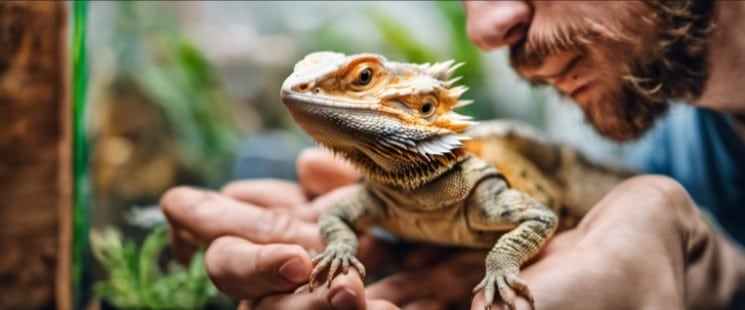
As we explore the natural habitat of bearded dragons, it’s important to understand their environment and how it shapes their dental structure. Bearded dragons are native to Australia and can be found in diverse ecosystems such as deserts, woodlands, and scrublands.
This range of habitats exposes them to different food sources, ultimately influencing their dental adaptations.
There are several species within the Pogona genus of bearded dragons, with some of the most well-known ones being the Central Bearded Dragon (Pogona vitticeps) and the Rankin’s Dragon (Pogona henrylawsoni).
Each of these species has a unique set of teeth, suited to their diets and foraging habits.
Bearded dragons possess a unique dental structure characterized by the following:
- Strong, conical teeth
- Tooth replacement throughout their lives
- Tessellated jawbones to anchor teeth
In the wild, bearded dragons exhibit a wide range of diet preferences, consuming both plant and animal matter. They’re considered omnivorous, feasting on insects, small mammals, and various plant materials.
To accommodate these diverse food sources, their conical teeth are designed to crush and break down their prey, while small, sharp teeth in the back of their mouths help to grind plant matter into digestible particles.
Interestingly, some bearded dragons showcase slightly different dental structures based on their diet in the wild.
For example, the Pogona barbata, also known as the Eastern Bearded Dragon, tends to have more robust teeth than other species because it feeds on harder, larger insects like beetles.
Finally, in relation to the rex entity, it is important to note that the ‘rex’ term is often referred to as ‘superworms’ or ‘Morio worms,’ which are common food sources for captive bearded dragons.
These insects provide not only nutrition but also play a role in maintaining the dental health of bearded dragons by keeping their teeth clean and sharp.
Summary
Before we move on to the conclusion, we’ve summarized this article into a short list of key points for you to remember:
- Bearded dragons have acrodont dentition, which means their teeth are fused directly to the jawbones and not easily replaceable, making dental care important.
- Bearded dragons have between 40 and 80 small, triangular teeth suitable for their omnivorous diet of insects, vegetables, and fruits.
- Dental problems in bearded dragons include gum disease, tooth loss, and mouth rot, which can be caused by poor diet, genetics, and environmental stress.
- To prevent dental problems, bearded dragons need a clean and healthy environment, a balanced diet, regular checkups with a veterinarian, and proper handling.
Conclusion
There you have it!
It can be challenging to handle this reptile if you don’t know the basics of care, especially when it comes to their teeth.
We hope you learned something valuable from this article.
If you have something to add, please let us know in the feedback section below; we take into consideration any feedback.
Other than that, have a wonderful day, take care!
Want to learn more about bearded dragons?
Ready to boost your knowledge to the next level? If so, check out the articles below:
- Can Bearded Dragons Eat Lavender? (Explained)
- Bearded Dragon Lighting: Ultimate How to Guide
- How to Avoid Bearded Dragon Bite (Checked and Solved)

